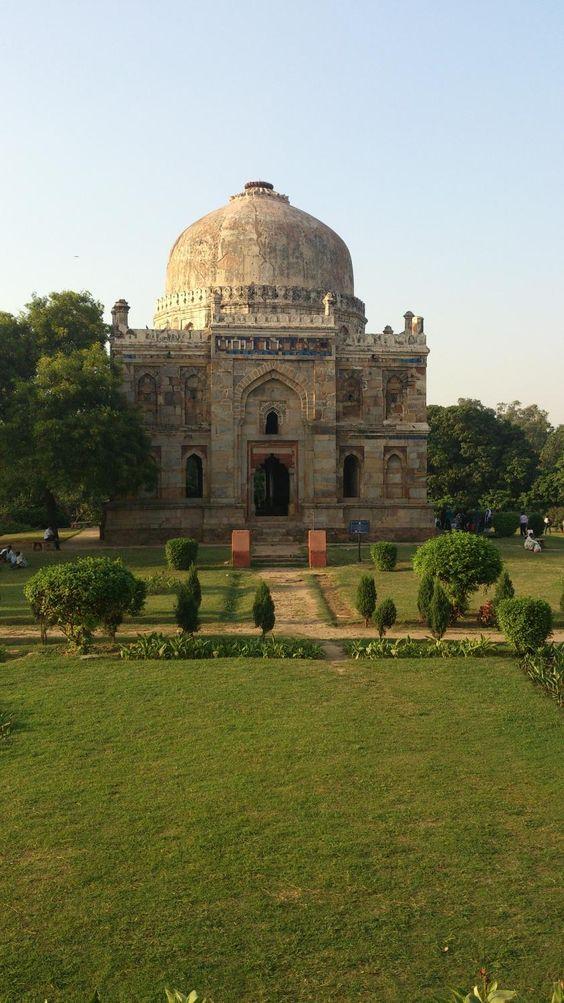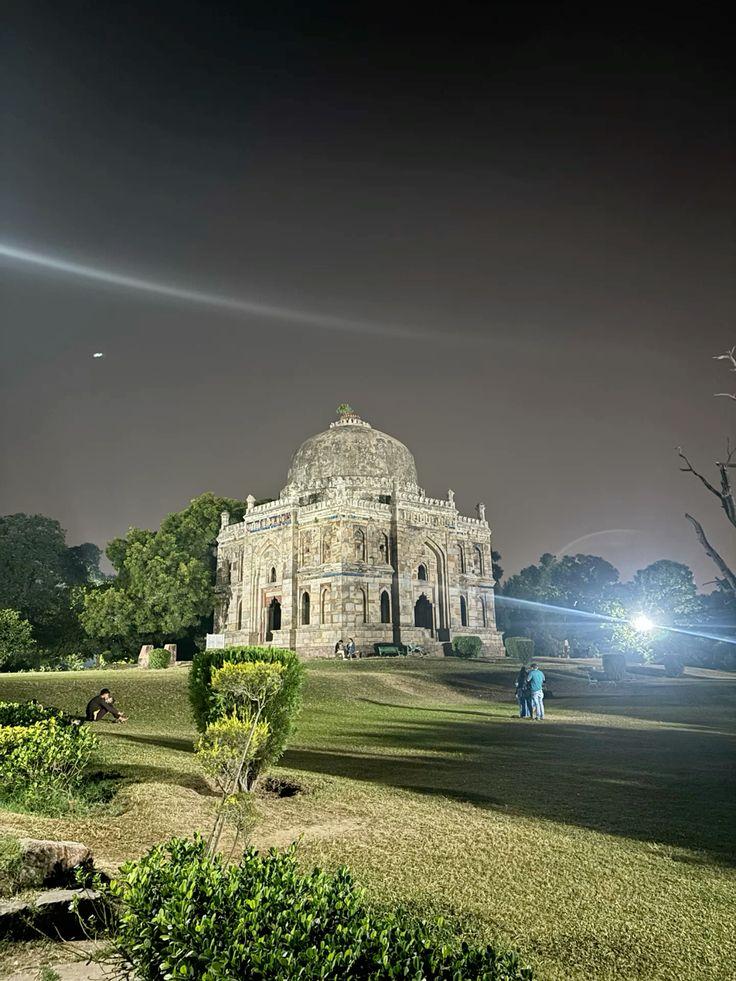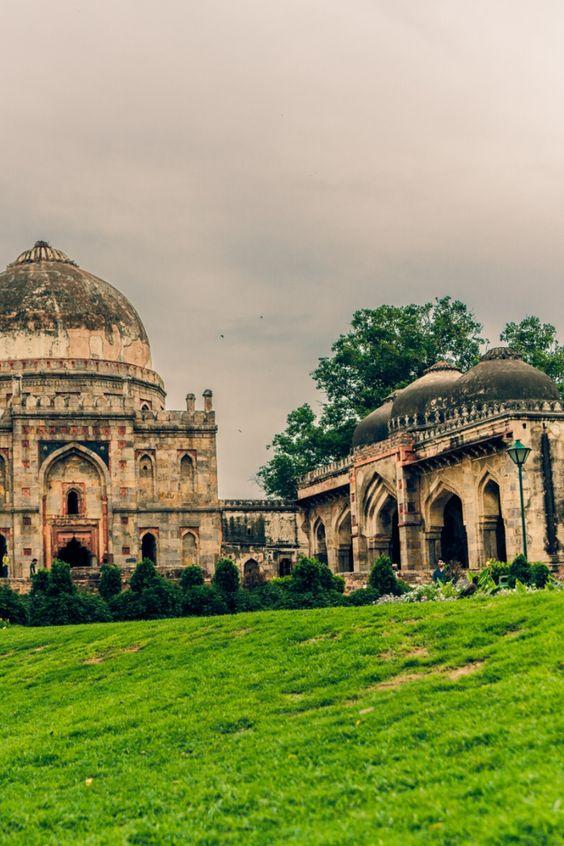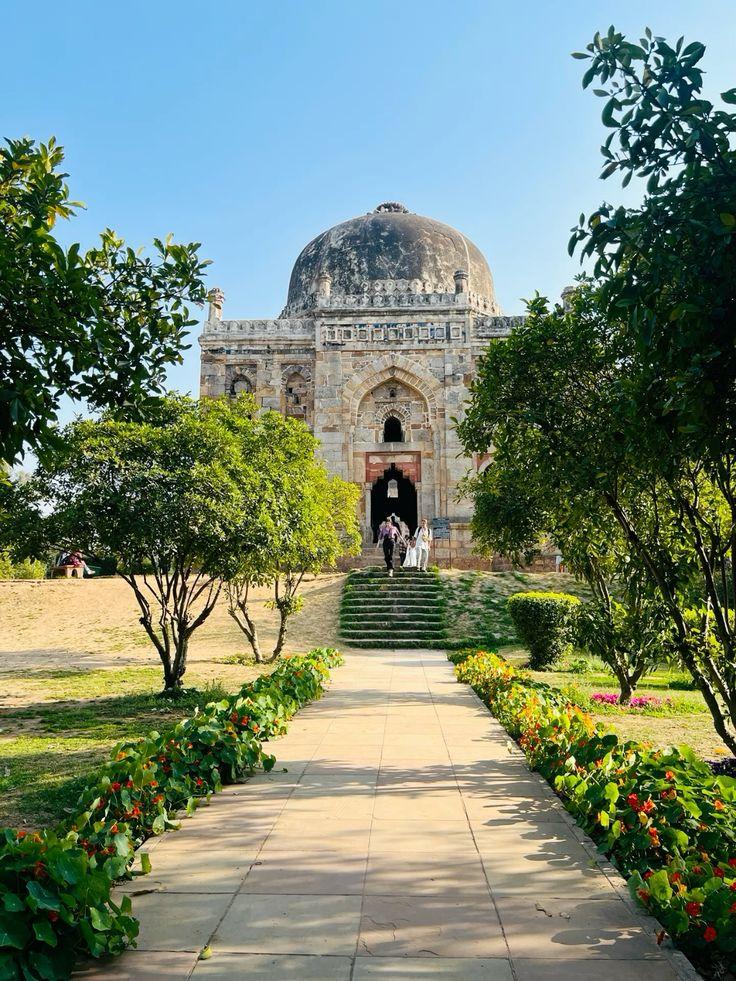



Table of Contents
- Introduction
- Historical Background
- British Era and Renovation
- Architectural Features
- Architectural Significance
- Ecological Diversity
- Flora
- Fauna
- Cultural Importance
- Community Engagement
- Artistic Inspiration
- Visitor Experience
- How To Reach Lodhi Gardens?
- Timings and Entry Fee
- Amenities
- Conclusion
- Faq's
Introduction
Lodhi Gardens, a sprawling 90-acre park located in the heart of New Delhi, is a remarkable blend of history, architecture, and nature. It serves as a crucial link to India's rich past while providing a serene escape for locals and tourists alike. This article delves into the intricate history, architectural significance, ecological diversity, and cultural importance of Lodhi Gardens, making it a must-visit destination in Delhi.
 Lodhi Garden, Delhi
Lodhi Garden, Delhi
Historical Background
Lodhi Gardens is steeped in history, with its origins tracing back to the 15th century during the rule of the Sayyid dynasty. The area was originally a burial ground for the royal family and nobles, reflecting the Islamic tradition of constructing tombs in gardens. The earliest structure within Lodhi Gardens is the tomb of Mohammed Shah, built in 1444 by his son, Ala-ud-din Alam Shah. This tomb is significant not only for its architectural style but also for its historical context. The Sayyid dynasty was known for its relatively short reign, but it played a crucial role in paving the way for the more illustrious Lodi dynasty.
The architecture of Mohammed Shah's tomb features an octagonal design, which is relatively unique among Indo-Islamic structures. The tomb is adorned with intricate carvings and decorative motifs that showcase a blend of Hindu and Islamic architectural styles. This fusion reflects the cultural syncretism that characterised Delhi during this period. The presence of chhatris (domed pavilions) adds to the aesthetic appeal, creating an atmosphere of tranquility and reverence.
With the advent of the Lodi dynasty, which ruled from 1451 to 1526, Lodhi Gardens saw further development and embellishment. Sikandar Lodi, who ascended to the throne in 1489, commissioned several monuments within the gardens, including his own tomb. This tomb, completed in 1517, is larger than Mohammed Shah's and features elaborate Mughal-style decorations that highlight the architectural advancements of the time.
The British colonial period marked a significant transformation for Lodhi Gardens. In 1936, British authorities undertook renovations to create a landscaped park named Lady Willingdon Park, named after the then-Viceroy's wife. This initiative involved relocating nearby villages and introducing exotic trees and plants to enhance the gardens' beauty. The British also constructed pathways and recreational areas that made it more accessible to the public.
Post-independence in 1947, Lodhi Gardens was renamed to honor its historical significance. In 1968, landscape architect Joseph Stein was commissioned to redesign the gardens, introducing features such as an artificial lake and glasshouses while preserving its historical essence. Today, Lodhi Gardens stands as a testament to Delhi's rich history and cultural heritage, attracting visitors from all walks of life who come to explore its beauty and significance.
Also Read: Natraj Market, Malad: A Shopper's Paradise in Mumbai
British Era and Renovation
The British era brought about significant changes in India's urban landscape, including Lodhi Gardens. As colonial powers sought to impose their vision of order and aesthetics on Indian cities, they often overlooked or repurposed indigenous spaces. Lady Willingdon Park was established as part of this effort in 1936 when British authorities decided to transform Lodhi
Gardens into a landscaped park that would reflect colonial ideals of beauty and leisure.
During this period, several villages surrounding the gardens were relocated to make way for extensive landscaping. The British introduced various exotic plant species from different parts of the world, creating a more diverse flora than what existed previously. While this beautification process aimed at enhancing public enjoyment, it also led to significant alterations in the original landscape that had historical significance.
The introduction of formal pathways allowed for organized movement within the park while encouraging leisurely strolls among visitors. With manicured lawns and strategically placed benches for relaxation, Lady Willingdon Park became a popular spot for both locals and expatriates living in Delhi. The park was designed not just as a recreational space but also as a venue for social gatherings and events.
Despite these changes, efforts were made to preserve some of the historical monuments scattered throughout Lodhi Gardens. The British recognized the importance of these structures as symbols of India's rich heritage and took steps to ensure their maintenance. However, their approach often involved a Western perspective on conservation that sometimes clashed with local traditions.
After India gained independence in 1947, there was a renewed interest in preserving cultural heritage sites like Lodhi Gardens. The park was renamed back to its original name Lodhi Gardens and efforts were made to restore its historical significance while maintaining its role as a public space.
In 1968, American landscape architect Joseph Stein was commissioned to redesign Lodhi Gardens once again. His work involved restoring many original features while introducing new elements like an artificial lake that enhanced biodiversity within the park. Stein's vision aimed at creating a harmonious blend between nature and history a philosophy that continues to guide conservation efforts today.
Architectural Features
Key Monuments
Lodhi Gardens is renowned for its impressive array of architectural marvels that reflect both historical significance and artistic brilliance from different eras:
Tomb of Mohammed Shah
This octagonal tomb is one of the earliest structures within Lodhi Gardens and serves as a prime example of Indo-Islamic architecture from the Sayyid dynasty. Its design incorporates intricate stone carvings featuring floral motifs and geometric patterns typical of Islamic art. The central dome rises majestically above eight smaller chhatris surrounding it each adorned with beautifully crafted finials that enhance its grandeur.
 Tomb of Mohamand Shah, Lodhi Gardens, Delhi
Tomb of Mohamand Shah, Lodhi Gardens, Delhi
Tomb of Sikandar Lodi:
Built between 1517-1518 by his son Ibrahim Lodi after Sikandar's death, this grand mausoleum stands out due to its larger size compared to other tombs in Lodhi Gardens. Unlike Mohammed Shah's tomb which has an open design featuring chhatris around it; Sikandar Lodi's tomb is enclosed with battlements adding an element of fortification a reflection on how power dynamics influenced architecture during this era.
 Tomb of Sikander Lodi, Lodhi Gardens, Delhi
Tomb of Sikander Lodi, Lodhi Gardens, Delhi
Bara Gumbad:
Constructed during Sikandar Lodi's reign around 1494, this large dome serves as both a gateway leading into an adjacent mosque complex known as "Jama Masjid." Its impressive size makes it one of Delhi's most recognizable landmarks; visitors are often captivated by its intricate stonework featuring floral patterns carved into sandstone a hallmark characteristic found throughout many Indo-Islamic structures across India.
 Bara Gumbad, Lodhi Gardens, Delhi
Bara Gumbad, Lodhi Gardens, Delhi
Shisha Gumbad:
Known colloquially as "Mirror Dome," this mausoleum features glazed tiles that shimmer under sunlight creating an enchanting visual effect reminiscent of stars twinkling at night sky above them! It houses graves believed to belong either members from Sikandar Lodi's court or possibly Bahlul Lodi himself; however exact identities remain uncertain due lack documentation available today.
 Shisha Gumbad, Lodhi Gardens, Delhi
Shisha Gumbad, Lodhi Gardens, Delhi
Athpula Bridge:
A stunning example built during Emperor Akbar's reign (1556-1605), this bridge showcases Mughal architectural elegance through its seven arches supported by eight pillars each adorned with delicate carvings reminiscent of floral motifs commonly seen throughout Mughal architecture
These monuments collectively represent not only architectural brilliance but also serve as reminders about cultural exchanges occurring across centuries where different dynasties left their indelible mark upon landscapes they governed.
Architectural Significance
The architectural significance found within Lodhi Gardens extends beyond mere aesthetics; it reflects broader socio-political dynamics shaping Indian history over centuries. Each monument tells stories about rulers who commissioned them offering insights into their values beliefs traditions practices prevalent during respective eras!
The use of octagonal designs found prominently across various structures signifies influence derived from Persian architecture while intricate carvings showcase local artisans' skills blending indigenous styles with foreign techniques introduced through trade interactions and cultural exchanges over time.
Ecological Diversity
Lodhi Gardens serves not only as an archaeological treasure trove but also as an ecological haven teeming with biodiversity a vital aspect contributing towards overall environmental health urban areas like Delhi. Spanning approximately 90 acres; this expansive park boasts over 7,000 trees representing around 215 species alongside numerous flowering plants creating vibrant tapestry colors textures throughout the year.
Flora
The gardens feature diverse flora encompassing both native and exotic plant species, contributing to the ecological richness found here.
Native Trees: Prominent species include Peepal (Ficus religiosa), Banyan (Ficus benghalensis), Neem (Azadirachta indica), Gulmohar (Delonix regia), Jamun (Syzygium cumini), among others. These trees not only provide shade for visitors seeking refuge from the scorching sun but also serve critical ecological functions by supporting local wildlife and offering habitats and nesting sites for birds and insects.
Flowering Plants: Seasonal flowers such as marigolds and roses bloom throughout different times of the year, adding bursts of color and fragrance, enhancing the overall aesthetic appeal of the gardens. Bougainvillea and hibiscus further contribute to the vibrancy while attracting pollinators like bees and butterflies, essential for maintaining healthy ecosystems.
Additionally, specialised areas within the gardens, such as the National Bonsai Park, showcase over 250 varieties of bonsai trees, offering unique insights into the art of horticulture. This section serves an educational purpose, promoting awareness about traditional gardening techniques and sustainable practices for preserving biodiversity."
Fauna
Lodhi Gardens is not only known for its impressive flora but also for the rich fauna that inhabits the space, making it an ideal destination for birdwatchers and nature enthusiasts alike. Over 150 species of birds have been recorded here, including both resident and migratory varieties, adding a dynamic element to the ecosystem.
Resident Birds: Commonly seen species include parakeets (Psittacula krameri), kingfishers (Alcedo atthis), pigeons (Columba livia), and peacocks (Pavo cristatus), each playing a vital role in maintaining the balance of the ecosystem while captivating visitors' attention with their vibrant plumage and melodious calls.
Migratory Birds: During certain seasons, migratory birds flock to the gardens, seeking refuge amidst the lush greenery, providing opportunities to observe rare species that are often difficult to spot in urban settings. Birdwatching enthusiasts can delight in spotting various migratory species, enriching the overall biodiversity experience offered here.
The park's diverse ecosystem makes it an ideal location for educational programs focused on environmental conservation and biodiversity awareness initiatives, aimed at fostering an appreciation for the natural world among visitors young and old alike.
Cultural Importance
Lodhi Gardens serves a multifaceted role, extending beyond being a mere historical site. It plays a vital part in Delhi's cultural landscape, enriching community engagement, artistic inspiration, and providing educational opportunities for residents and tourists alike.
Community Engagement
The popular Lodhi Gardens is a gathering place for locals, attracting individuals and families seeking respite amidst nature and engaging in recreational activities such as jogging, yoga, picnicking, and photography. Its expansive lawns provide ample space for families and friends to gather and enjoy leisurely afternoons surrounded by the beauty of greenery and tranquility offered here.
Various community events are organized throughout the year, further enhancing engagement opportunities and fostering a sense of belonging among residents. Heritage walks are conducted by organisations like INTACH (Indian National Trust for Art and Cultural Heritage) to raise awareness about the site's historical significance, while also encouraging active participation from community members in preserving the heritage through collective efforts.
Moreover, local artists frequently visit the gardens seeking inspiration due to the picturesque surroundings and rich history. Photographers capture stunning images showcasing the interplay of light and shadow across monuments and landscapes, creating visual narratives that reflect the essence of the culture captured within these hallowed grounds.
Artistic Inspiration
Artists often find themselves drawn towards Lodhi Gardens due enchanting ambiance created by harmonious blend nature history. Photographers capture stunning images both nature architecture throughout different seasons transforming ordinary moments into extraordinary visual narratives celebrating beauty simplicity found everyday life.
Art exhibitions music performances held within gardens serve platforms showcasing local talent promoting cultural exchange fostering appreciation artistic expressions among diverse audiences. These events create vibrant atmosphere transforming spaces into lively hubs creativity collaboration connecting individuals through shared experiences celebrating diversity community spirit alive thriving here.
Visitor Experience
Accessibility
Lodhi Gardens enjoys a strategic location, making it easily accessible from various parts of Delhi. The city is known for its bustling urban life, characterized by heavy traffic congestion and public transport challenges faced by daily commuters seeking to escape the chaos of the city streets.
Location:
Situated between Khan Market and Safdarjung's Tomb on Lodhi Road, the gardens are centrally located, ensuring convenient access for residents and tourists alike who wish to explore the rich history and natural beauty encapsulated within these grounds.
Also Read: The Best Sunrise Spots in Kolkata
How To Reach Lodhi Gardens?
Public Transport:
The nearest metro stations, Jorbagh Metro Station and Lok Kalyan Marg Metro Station, provide convenient access via the Delhi Metro network, which is one of the most efficient modes of transportation in the city. Auto-rickshaws are readily available throughout Delhi, further facilitating movement towards gardens, allowing visitors to reach their destination in a hassle-free manner without relying on personal vehicles and navigating congested roads often plagued by traffic jams and delays experienced during peak hours.
Timings and Entry Fee
Opening Hours:
April September: 5:00 AM - 8:00 PM
October March: 6:00 AM - 8:00 PM
Entry Fee: Free
Visitors can freely explore the gardens without any restrictions, engaging in leisurely activities such as reading, picnicking, and photography, allowing them to immerse themselves in the tranquility and serenity offered here without worrying about additional costs associated with visiting attractions elsewhere in the city.
Amenities
To enhance visitor experiences; Lodhi Gardens offers several amenities designed cater needs of guests ensuring a comfortable enjoyable stay while exploring beautiful surroundings:
Walking Paths: Well-maintained pathways allow for leisurely walks and jogging amidst lush greenery, inviting exploration and discovery of hidden corners and gems waiting to be uncovered by curious wanderers eager to embrace the beauty of the surrounding nature.
Seating Areas: Benches scattered throughout the gardens provide perfect spots for relaxation and contemplation - moments of reflection allowing visitors to take a break and recharge before continuing their journey to explore the wonders that await them ahead.
Children's Play Area: A designated space for children ensures family-friendly enjoyment, providing a safe and fun-filled environment where kids can play, interact, and socialize, creating cherished memories for years to come.
National Bonsai Park: A section dedicated to showcasing various bonsai trees adds another layer of interest for gardening enthusiasts, offering unique insights into the art of horticulture while inspiring creativity and nurturing a green thumb among visitors eager to learn more about traditional practices and sustainable gardening techniques employed by the skilled artisans to create the miniature masterpieces proudly displayed here.
Also Read: Chikka Tirupathi Temple: A Spiritual Gem Near Bangalore
Conclusion
Lodhi Gardens is a significant landmark in Delhi that showcases rich Mughal history and provides a peaceful retreat from urban life. Its blend of natural beauty and architectural significance makes it one of Delhi's most cherished public spaces. Whether you are interested in history, architecture, ecology, or simply looking for a tranquil spot to unwind amidst nature's beauty, Lodhi Gardens offers something for everyone. As visitors stroll through this historical gem surrounded by ancient trees and magnificent monuments, it reminds us that within these confines lies a treasure that bridges the past and present in a harmonious symphony.
explore further
Latest from Home Buying Tips
More from Recommendations
Resources
Dwello, for every home buyer, is a way to go from 'I feel' to 'I know', at no extra cost.




